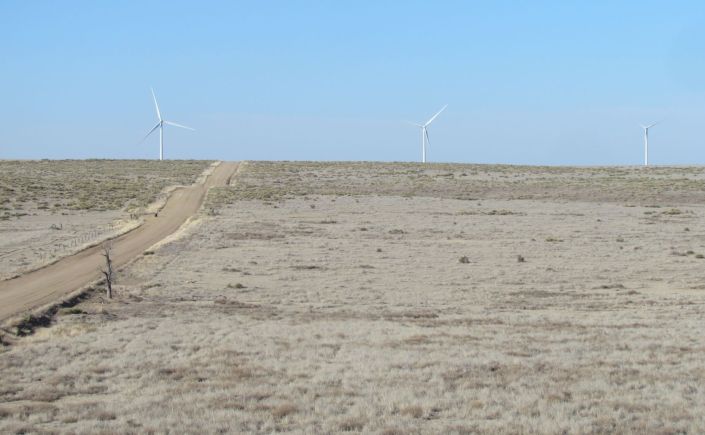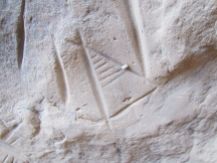In addition to constant Snow Goose sightings, the High Plains Snow Goose Festival in Lamar last month offered many memorable moments. Colorado is known chiefly for its Rocky Mountains, but over a third of our state occupies the Great Plains. Despite a dearth of peaks and a landscape that appears monotonous and barren at first glance, the plains scenery is variable and punctuated by unexpected rises and falls, as we festival participants experienced during field trips to both public and private properties.
To enlarge a photo, click on it. To read its caption, hover cursor over it.
The plains are windy places, and not a single day passed without a breeze at best, gale-force gusts at worst. During the three-day event, we enjoyed only a few calm hours. On a single-digit morning, we braved a biting wind, before it blew us back into our vehicle. At times, we hid behind the bus or a building in order to steady our binoculars and cameras. Native Americans and homesteaders had to be a hardy lot to survive in this challenging climate, with freezer- and furnace-like conditions alternating in the course of the year. Petroglyphs and smoke-darkened caves bespeak long-term human activity in the region, and ruined homes and artifacts tell of those hopeful settlers who arrived, but could not make a go of things.
Lamar exists because the Mountain Branch of the Santa Fe Trail traversed the southeastern portion of Colorado. From 1821 until 1880, the legendary trade route connected the US with Santa Fe, which was part of Mexico until 1848, when it was appropriated by the US. The arrival of the railroad consigned the trail to history books, until the 1987 creation of the Santa Fe National Historic Trail by the National Park Service. A series of historical markers, which we encountered on several occasions, recall its historic significance.

Lamar mural

Lamar mural
While Coloradans have reason to celebrate some past events, we still try to come to terms with others. Southeast Colorado has borne witness to, and bears the scars of, several inglorious acts. It saw the 1864 Sand Creek Massacre, in which Colorado militia attacked a group of peaceable Arapahoe and Southern Cheyenne, camped under express US government protection. Close to 200 persons perished, among them women and children. The area also witnessed the construction of Camp Amache, one of ten internment camps that imprisoned American citizens of Japanese descent from 1942 until 1945, in the wake of the attack on Pearl Harbor in World War II.
Wherever I am, experiencing the beauty and order of the natural world while being reminded of some of the inhuman acts perpetrated by humans on one another is a source of never-ending sadness and outrage. I continue to struggle with negativity and cynicism about humankind, but I don’t want to give up hope that we can yet find a way to make this earth a welcoming home for all people, as well as for all our fellow creatures.



















You’re right that many people don’t know how different the eastern third of Colorado is from the rest of the state: Great Plains versus Rocky Mountains. In 2017 we drove north from Austin heading for South Dakota. The day we left Amarillo (Texas) we came up the eastern edge of Colorado on US 385 and so must have passed through Lamar. Our goal was to keep pushing further north, so I can’t remember Lamar. Wikipedia says “The city was named after Lucius Quintus Cincinnatus Lamar II during the period that he was Secretary of the Interior in the futile hope that the then town would be named as the land office.” Seems his parents were fond of Roman history.
Even down here on the Blackland Prairie east of Austin the wind is an almost permanent presence, as I can attest from years of photographing plants that didn’t want to hold still. As you probably know, roadrunners are an occasional sight down here too, though I couldn’t tell you what species.
LikeLiked by 2 people
Good morning, Steve,
Thank you for the interesting information about Lamar. Place names often have a profound history and reflect the wishes and plans of earlier generations. I did not know about Lucius Quintus Cincinnatus, who, it is expected, rarely wrote out his full name.
You have likely seen Greater Roadrunners, since Lesser occur along the West Coast of Central America. Unless one ventures across the border, we should not see them in the US.
LikeLike
I learned something, because I thought that Colorado was mostly The Rockies!
LikeLiked by 2 people
I think it’s a common misperception, Christa. Wyoming and Montana are similar in that they share the eastern plains and the Western Rockies, but the farther north, the harsher the winters (as you know first hand 😊).
LikeLiked by 1 person
Absolutely beautiful photos!!!
LikeLiked by 1 person
I am glad you enjoyed the photos of a lesser-known part of Colorado, Valerie.
Happy spring!
Tanja
LikeLiked by 1 person
Happy Spring to you too! May winter be over!
LikeLiked by 1 person
I remember-you are not a winter person! 🙂
LikeLiked by 1 person
Very nice! I always impressed by your decent and humble approach. Thanks a lot, we need to know more about your lovely country (It’s so huge and different!) and I don’t know much about it, at all as a German. It definitely makes me more knowing and familiar with all the lovely landscapes. I wonder why I never have been there, despite a stop in Puerto Rico, which was only for a day and doesn’t count if it someone would like to know something about your marvelous nature there.
LikeLiked by 2 people
Thank you for your interest, Ira. The country is definitely vast and varied, and I doubt that anybody could explore all parts of it during one’s lifetime. But I think that is true about most countries, even if they are smaller.
LikeLiked by 1 person
Hello there. Real good essay. I’m less hopeful than you are in re humanity’s prospects.
My fave photo is the one of the Greater Roadrunner blending in with the tree trunk.
Neil
LikeLiked by 1 person
I appreciate the comment, Neil. The truth is that I am not optimistic, but am constantly fighting my cynicism and sadness about the human race, because otherwise what would be the point of living on?
And then I see a creature like a Roadrunner and it makes me insanely happy, so I would like to be around to see as many birds and other animals as possible. Is that completely crazy?
BTW, did you happen to see a Roadrunner during your time in N.M.? They are relatively common there.
LikeLiked by 1 person
Well, there are loads of peaceful, reasonable people. And there are, and always have been, loads who aren’t. The latter are the problem.
You’re not crazy. You’re sane.
I didn’t see a roadrunner!
LikeLiked by 1 person
Sorry about the roadrunner, Neil, but I hope you will get another opportunity. And I thank you for the “sane” certification. 😊
LikeLiked by 1 person
You are a stellar writer and I enjoy reading all of your posts.
LikeLiked by 2 people
Thank you, Steve. That makes my writing heart very happy. 😊
LikeLiked by 2 people
Das ist ja ein interessantes Stück amerikanische Geschichte! Und ich liebe die Bilder von den Truthähnen und dem Roadrunner!
LikeLiked by 2 people
Die Geschichte finde ich auch interessant, wenn auch oft unerfreulich. Aber die Vögel machen immer Freude, und Roadrunners zählen zu meinen absoluten Lieblingen.
LikeLiked by 2 people
Die Santa Fe Railroad mit der alten Dampflokomotive sieht toll aus und die amerikanische Geschichte dort in Colorado klingt interessant
LG Andrea
LikeLiked by 1 person
Dankeschön, liebe Andrea. Auf die Fußstapfen folgten die Hufe, die Planwagen, die Schienen und zuletzt die Autoreifen, und alle hinterließen ihre Spuren.
LikeLiked by 1 person
Really fascinating post. Such an inspiring landscape. I hear what you are saying about the native people. In the last few years Concord MA has been coming to terms with the slavery that went on in that town during the time of Emerson and Thoreau and all those “enlightened” folks. Finally, they have an exhibit about it.
LikeLiked by 1 person
Thank you. I think if we want to make this country a better place for all its citizens, we have to talk about and acknowledge the misdeeds committed in the past, and try to rectify them as much as possible, without simply paying lip service because it’s politically or socially expedient. A foundation built on bad soil will not last.
LikeLiked by 1 person
How beautiful!!
LikeLiked by 1 person
I am glad you think so, Diane. Thank you! 🌸
LikeLiked by 1 person
Wonderful captures, both landscape and wildlife! I love your Wild Turkey family and Great Horned Owl shots! Colorado is indeed a lovely place with many scars. I’m with you, Tanja, I can only hope than humankind can become more compassionate and caring for all for the sake of our earth and wildlife.
LikeLiked by 1 person
Thank you, Donna. I have to admit that I am constantly fighting my pessimism about the future of this planet. We know that something needs to be done, yet we continue to live as if there were no tomorrow. 😪
LikeLiked by 1 person
Hallo Tanja,
tolle Bilder, tolle Geschichte, tolle Gegend…da wäre ich auch gerne mal !
Lieber Gruss aus Hamburg von Jürgen
LikeLiked by 1 person
Es ist eine faszinierende Gegend, und es freut mich, daß Dir die Reise dorthin gefallen hat.
Herzliche Grüße und ein schönes Wochenende aus Colorado, wo es gerade schneit!
Tanja
LikeLiked by 1 person
I grew up in Southeastern Colorado. It’s such a beautiful area and I’m so thrilled to be moving back to my home state. Love your pictures and I’m glad I found your blog!
LikeLiked by 1 person
I just read about your plans to relocate. I love that part of Colorado and hope to be back there before too long. I, too, am glad you found my blog. 😊
Thank you, and best wishes for your move.
LikeLiked by 1 person
I’m moving to central Colorado, so I’ll be in the mountains instead of the mesas, canyons and plains of my youth. I’m looking forward to being back in the wide open.
LikeLiked by 1 person
You actually wrote that, but it did not sink in when I read it. Living in the mountains will be beautiful, and if you need your prairie fix, it will be within easy reach!
LikeLiked by 1 person
I would love to visit my old grade school and the ranches where we lived. Perhaps I will take my son on a road trip so that I can show him where I grew up.
LikeLiked by 1 person
That sounds like a great idea. It would give him a better understanding of his family’s roots. Maybe you will have time to take him to Bent’s Old Fort, too!
LikeLiked by 1 person
I think so!!
LikeLiked by 1 person
Petroglyphs!!! I’m intrigued by those vast plains and the lives of the indigenous who once occupied the region. Do you know what specific tribes lived here and their history? Is there any information near the petroglyphs regarding this?
LikeLiked by 1 person
This particular petroglyphs were modern, probably dating to the 19th century. They were not marked and were pointed out to us by a local tour guide. I don’t think he knew exactly who etched them in the stone, but in general, the Southern Cheyenne, Arapahoe, Kiowa lived or migrated through that part of Colorado.
LikeLiked by 1 person
very interesting. 😀
LikeLiked by 1 person
I am glad you found it interesting. Thank you for visiting and taking the time to comment.
LikeLike